Just the thought of needing to replace your roof can create anxiety if you’re like most people.
Replacing your roof is expensive and time-consuming. Overall, a flat roof tends to have a longer lifespan than a pitched roof, and a flat roof is initially cheaper to install. They may require more upkeep than a pitched roof, though.
With most residential roofing companies, you may get a warranty for anywhere from 10 to 20 years, but you might get 25 years out of a flat roof if you maintain it well. Your climate, maintenance routine, and other variables can affect this.
With that in mind, those decades do come and go quickly, even if you’re able to make it that long, so what happens then?
Signs You Need to Replace Your Roof
If your roof is older than 20 to 25 years, it may need to be replaced. If you’re buying a home, you should ask the last time the roof was replaced. Other signs you might need to get a new roof include:
- Your shingles are curling or buckling.
- If the shingles in your roof valleys are missing or breaking, you might need a new roof. This is important because if there’s damage to this area, it can make your home vulnerable to a leak.
- Are your gutters filling with pieces of your shingles? As your shingles age, the granules start to shed.
- Can you see daylight through your roof boards when you’re in the attic?
- If your roof seems like it’s sagging, that’s a major problem that needs to be corrected right away, typically indicating you have a structural issue.
If you don’t know how long ago your roof was last replaced, you might have to look around and see if you can find any kind of paper trail.
Compare Materials
If it is time to replace your roof, one of the big decisions you will have to make will be the material.
If you choose asphalt composite shingles, these are affordable but maybe not as attractive. They are the most popular roofing material far and away, though.
Another more expensive but also perhaps more visually appealing option are wood shakes or shingles. They’re durable, but if you live in a place where there’s a fire risk, you shouldn’t choose this. A metal roof is durable and fireproof, but they require a specialized contractor to do the work. They do have a long lifespan, which might make them worth the higher price.
Slate roofing is expensive and heavy, and if they get damaged, they’re hard to repair.
Other options include composition slate, and in the sunbelt, clay or ceramic tile is often used.
Shop Around
Some of the factors that weigh into the cost to replace your roof include the materials you choose, your contractor, the steepness of your roof, also known as the pitch, and the square footage.
If you have a small home and get a simple composite roof, the price may be as low as $7,500. For more expensive options, it can be tens of thousands of dollars.
You should get several estimates to compare prices, but be aware that cheaper isn’t always better.
You might also want to think about having the work done off-season.
For roofing teams, the off-season is usually in the winter and early spring. If you live somewhere with a relatively mild climate, this may be more doable for you.
The Process
In general, if you’re hiring a contractor that has an experienced crew, it could take less than a week to replace the roof on a moderately sized house.
Typically, the first step is to remove your existing material and get rid of it. The crew should protect your landscaping and use magnetic tools to get up any nails.
Then, the crew might make repairs on your roof that are minor if it’s in good condition. Otherwise, they may replace boards.
From there, if you live somewhere requiring it, a roofing crew will install ice dam protection to prevent ice that melts from backing up under the sheathing and causing moisture damage.
Next, asphalt paper is laid, and then a metal drip edging is applied.
Flashing installation is done anywhere there could be leaks, and then there’s the installation of what’s called a ridge vent, which helps air circulate in your attic.
Finally, since it is a significant and often expensive project, you might need to finance it with something like a home equity loan or home equity line of credit. Some contractors will also let you pay in installments.




















